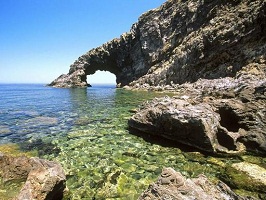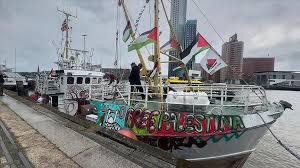Italy’s best-kept secret: A low-key hideaway far from fanfare

Rome: Known as “the black pearl of the Mediterranean” for its striking black-lava cliffs, the volcanic island of Pantelleria—the largest of Sicily’s satellite isles, at 32 square miles—has long lured a smattering of in-the-know travelers seeking a low-key hideaway far from the fanfare of high-profile hotspots like Capri and Portofino.
Having bubbled up to the ocean’s surface some 300,000 years ago, Italy’s southernmost point—located 70 miles southwest of Sicily and a mere 40 miles east of Tunisia—bears the ethnic and archaeological footprints of its many disparate residents over the centuries, which included the Phoenicians, Carthaginians, Romans, Normans, and most notably the Arabs, who arrived 1,000 years ago. Its storied history—coupled with a dazzling, almost otherworldly landscape and arid, windswept climate—informs its rugged and ancient charm.
The island’s steadfast gales, which gust from the Channel of Sicily nearly 340 days a year, have formatively shaped Pantelleria’s past and present; fittingly, its Arabic name, Bent el Rion, means “daughter of the wind.” These battering breezes, along with lingering signs of its fiery origins—like favare, mini-geysers found close to the island’s craters that emit boiling jets of steam every now and again—create an atmospheric restlessness that contrasts sharply with Pantelleria’s prevalent silence and distinct lack of tourist sprawl. This intriguing juxtaposition underpins the island’s inimitable ambiance, which has drawn Italian glitterati (like Giorgio Armani, who has owned a villa here for more than 40 years) to its sunbaked shores for decades.
To experience this pristine Mediterranean paradise in peerless style, hop an hour-long flight from Palermo (or one direct from Milan, Rome, Venice, Bergamo, or Bologna) and head straight to Sikelia, the island’s first bona fide luxury hotel. Ten years in the making before its 2016 debut, the ultrachic oasis is the passion project of Giulia Pazienza Gelmetti, a winemaker who counts professional basketball player and financier among her past careers. Created from dammusi—the island’s iconic stone dwellings, designed by the Arabs with shallow-domed roofs to collect valuable rainwater—it’s a sublime secret world tucked behind a shimmering, 1,500-pound brass door and artfully imbued with Pantelleria’s singular spirit.
Sikelia’s 19 suites, each unique, are painted in the island’s earthy tones and impeccably combine furnishings upholstered in lush velvet and linen with edgy concrete, glass, and metal finishes. Gleaming Gessi fixtures and embroidered Frette linens speak to Pazienza Gelmetti’s uncompromising taste, as do hammered-metal wardrobes and oversized engraved panels by renowned Italian artist Gennaro Avallone.
The resort comes to life at dusk, when guests gather in the palm-studded courtyard under a sky ablaze in streaks of pink and violet for cocktails accompanied by nibbles like cucunci, a variety of Pantescan caper. (Caper plants blanket the island, their delicate, lily-white flowers bursting forth from fissures in the jet-black volcanic rock. Grown commercially here, they’re regarded by foodies as some of the world’s finest.) On a clear evening, you can climb a few stairs to the roof, negroni firmly in hand, and see Tunisia.
Then it’s time for dinner at Sikelia’s refined restaurant, Themà, where executive chef Diego Battaglia expertly melds Arabic and North African flavors with traditional Italian cuisine to delectable effect. Signature dishes include elegant seafood crudos, spaghetti with marinated oysters and monkfish foie gras, and codfish with cuttlefish ink and apple, washed down with wines from Sikelia’s sister property, L’Officina di Coste Ghirlanda, Pazienza Gelmetti’s enchanting winery and one of the island’s most popular draws. You can stroll its meticulously terraced vineyards and olive groves and marvel at its towering pink-peppercorn tree before dining at the candlelit al fresco restaurant on specialties like gnocchi with pistachio pesto and fritto misto.
Speaking of wine, Pantelleria’s Zibibbo grapes—which grow nowhere else on earth, and whose backbreaking cultivation is the only agricultural practice on the UNESCO World Heritage List—make the island an intriguing destination for oenophiles. Since its tireless winds keep flora from growing tall (local farmers carefully groom olive trees like oversize bonsais to buffer them against the gales), the muscat grapes—harvested by hand and used to produce Passito de Pantelleria, the island’s world-famous dessert wine—are a true triumph of nature over adversity, thriving close to the ground in small hollows that maximize shade and moisture.
Go vineyard hopping and taste another premium Passito at the island’s outpost of world-class Sicilian winemaker Donnafugata, whose 168 acres of vineyards on Pantelleria encompass 14 districts. You can also sample its other vintages—famous for their gorgeously painted labels—accompanied by small plates of Sicilian specialties like ravioli with fresh ricotta and mint and savory eggplant parmigiana. If you’re still hungry (this is Italy, after all), Le Cale, nestled between two of the island’s most breathtaking coves on its east coast and offering some of its most bewitching views, is a short drive away. Feast on dishes like spaghetti with garlic, oil, and raw red snapper while overlooking the Arco dell’Elefante, arguably Pantelleria’s most iconic landmark: an arresting lava formation that resembles a giant elephant dipping its trunk into the sea.
Pantelleria’s position as a stopover between Africa and Sicily, at the intersection of Mediterranean trade routes where sailors could rest and restock their ships, amplified its strategic appeal in bygone centuries. Its location begot its Greek name, Kossyros, or “the Smaller One,” likely because it followed the larger Malta as a navigational bellwether.
To view the island as countless mariners of antiquity did, take to the high seas to explore its craggy coastline and cavort in its crystalline, sapphire-blue waters. Sikelia offers daily excursions, complete with a freshly cooked lunch, aboard its traditional Tunisian fishing boat, which the hotel has stylishly adapted with its discerning clientele in mind. Or grab some famous Sicilian arancine (baseball-size rice balls) and vino and charter a gommone—an inflatable motorboat outfitted with a large sunbed and expert captain—from La Tortuga, a longtime local operator, at the main port and set sail.
A leisurely day navigating the network of spectacular sea caves and grottoes (many abutting perpendicular cliffs and accessible only by boat) and splashing in the shallows—where hot springs studding the seabed testify to the island’s ongoing volcanic rumblings—epitomizes la dolce vita at its summertime best. Afterward, a stop at Pantelleria’s famous Lago di Venere (also called Specchio di Venere, or “mirror of Venus”), a heart-shaped, cyan-hued natural lake acclaimed for its thermal springs and mineral-rich mud, is an idyllic sunset sojourn on this incomparable Italian isle.





